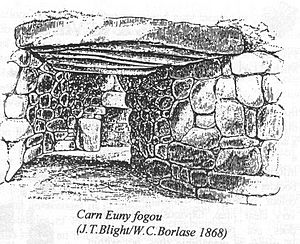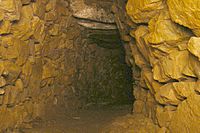Fogou facts for kids
A fogou (pronounced "foo-goo") is a special underground building made of dry stone. You can find these structures in Cornwall, a county in England. They were built during the Iron Age or when the Romans were in Britain.
People aren't completely sure what fogous were used for. Some old names for them in Cornwall include "fuggy-holes." Fogous are similar to other underground buildings called souterrains or earth-houses, which are found in northern Europe, especially in Scotland. So far, fewer than 15 fogous have been officially found.
Contents
How Fogous Were Built
Fogous are mostly underground. They have walls made of stones stacked without mortar, which means they are "dry-stone" walls. The walls usually lean inwards as they go up, forming a shape called a corbelled roof. Flat stone slabs then cover the top.
To build a fogou, people dug a sloping trench. This trench was usually about 1.5 meters (5 feet) wide and 1.8 meters (6 feet) deep. They lined the trench with dry-stone walls. The soil they dug out was often piled on top of the fogou, like at Pendeen Vau. Sometimes, the soil was used to build up the walls around the settlement, as seen at Halliggye Fogou.
What Were Fogous Used For?
The exact purpose of fogous is still a mystery! Experts have suggested a few ideas:
- They might have been places to hide.
- They could have been used for religious ceremonies.
- They might have been used to store food.
Fogous were often built in the middle of ancient settlements. This suggests they were very important to the people who lived there. Many fogous face southwest to northeast, with their entrance facing the wind.
Some fogous, like those at Halliggye, Carn Euny, and Boden, seem to have been filled in on purpose after people stopped using them or when the settlement was left empty.
Hiding Place Idea
One popular idea is that fogous were used as safe places or refuges. People might have hidden in them during attacks or raids.
Experts like Nancy Edwards have pointed out that fogous were often hidden underground. This would have helped people stay safe if there was a sudden attack. However, if an attack lasted a long time, these hidden places could become dangerous traps.
Food Storage Idea
Another idea is that fogous were used to store food. An ancient writer named Diodorus Siculus mentioned that Iron Age people in Britain kept their grain in "underground repositories." This supports the idea that fogous could have been used for storage.
Even though fogous can be damp today, some types of food might have been stored there. For example, they could have been good for drying meat. They might also have been used to store dairy products like milk, butter, and cheese. The natural dampness and molds could have helped keep these foods fresh.
Some fogous have special pits inside. These pits might have been used to preserve things like gulls' eggs, similar to how people did it on Saint Kilda in Scotland.
What Does "Fogou" Mean?
The word "fogou" might come from old Cornish words. These words are similar to fow (plural fowys) and gogow (plural gogowyow), which both mean "cave." In the past, people in Cornwall sometimes called them "fuggy-holes," but this name is not used much anymore.
History and Discoveries
Other underground buildings, like "earth houses" or souterrains, are similar to fogous. For example, some souterrains in ancient Gaul (now France) and medieval Ireland were used as hiding spots from raiders. Fogous might have had a similar purpose.
Archaeologists have found "stone balls" (called petrospheres) in some souterrains. These stone balls might have been symbols of power. This suggests that these underground places were not just for storing food but might have had other important uses too.
The TV show Time Team has explored two fogous: Boleigh Fogou in 1995 and Boden Vean in 2021. This helped people learn more about these mysterious structures.
Famous Fogou Sites
The Halliggye Fogou on the Trelowarren estate is thought to be the largest and best-preserved fogou.
Other fogous that are still in good condition include:
- Carn Euny
- Boleigh Fogou (near Lamorna)
- Pendeen Vau
- Trewardreva (near Constantine), which locals sometimes call Pixie's Hall or Piskey Hall.
Some fogous are partly damaged. For example, the one at Chysauster is looked after by English Heritage, but it has been blocked off for safety. Other partly destroyed fogous are at Boden Vean and Lower Boscaswell.
Archaeologists have also found signs of possible fogous that no longer exist, such as at Porthmeor and Treveneague. One was found during road construction on the A30, but it was later destroyed.
See Also
- Kiva – Another type of underground structure
- Erdstall – Mysterious underground tunnels found in Europe



